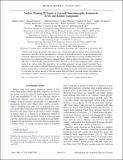Surface floating 2D bands in layered nonsymmorphic semimetals : ZrSiS and related compounds
Abstract
In this work, we present a model of the surface states of nonsymmorphic semimetals. These are derived from surface mass terms that lift the high degeneracy imposed on the band structure by the nonsymmorphic bulk symmetries. Reflecting the reduced symmetry at the surface, the bulk bands are strongly modified. This leads to the creation of two-dimensional floating or unpinned bands, which are distinct from Shockley states, quantum well states, or topologically protected surface states. We focus on the layered semimetal ZrSiS to clarify the origin of its surface states. We demonstrate an excellent agreement between density functional theory calculations and angle-resolved photoemission spectroscopy measurements and present an effective four-band model in which similar surface bands appear. Finally, we emphasize the role of the surface chemical potential by comparing the surface density of states in samples with and without potassium coating. Our findings can be extended to related compounds and generalized to other crystals with nonsymmorphic symmetries.
Citation
Topp , A , Queiroz , R , Grüneis , A , Müchler , L , Rost , A W , Varykhalov , A , Marchenko , D , Krivenkov , M , Rodolakis , F , McChesney , J L , Lotsch , B V , Schoop , L M & Ast , C R 2017 , ' Surface floating 2D bands in layered nonsymmorphic semimetals : ZrSiS and related compounds ' , Physical Review X , vol. 7 , no. 4 , 041073 . https://doi.org/10.1103/PhysRevX.7.041073
Publication
Physical Review X
Status
Peer reviewed
ISSN
2160-3308Type
Journal article
Description
Work at Argonne National Laboratory is supported by the U.S. Department of Energy, Office of Science, under Contract No. DE-AC02-06CH11357; additional support by National Science Foundation under Grant No. DMR-0703406. This work was partially supported by the DFG, proposal no. SCHO 1730/1-1.Collections
Items in the St Andrews Research Repository are protected by copyright, with all rights reserved, unless otherwise indicated.

